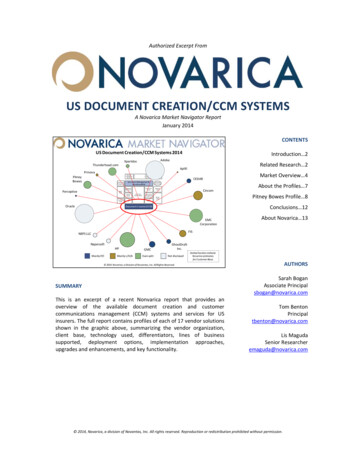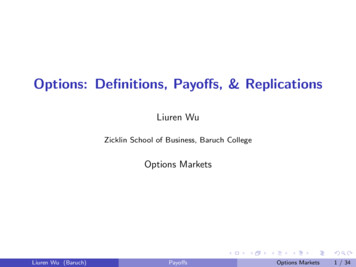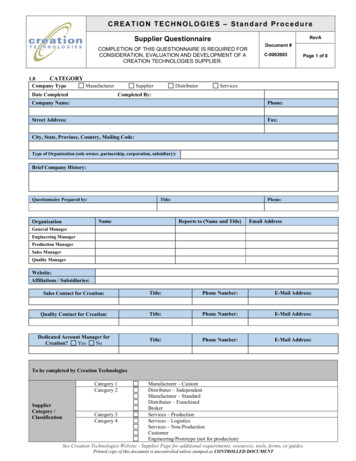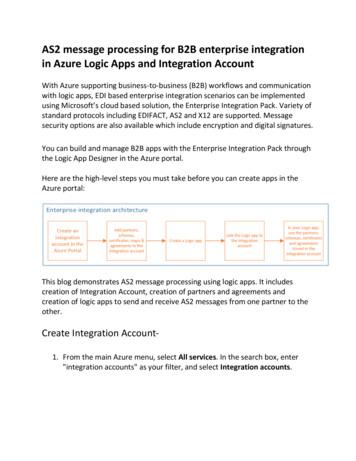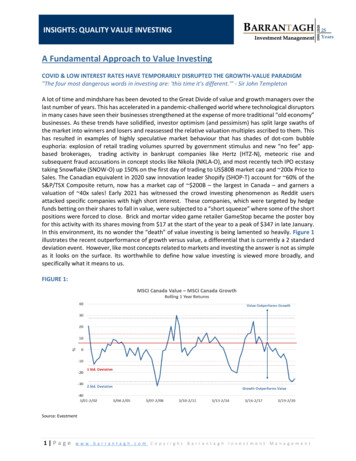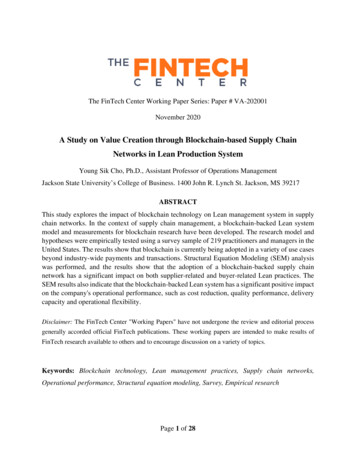
Transcription
The FinTech Center Working Paper Series: Paper # VA-202001November 2020A Study on Value Creation through Blockchain-based Supply ChainNetworks in Lean Production SystemYoung Sik Cho, Ph.D., Assistant Professor of Operations ManagementJackson State University’s College of Business. 1400 John R. Lynch St. Jackson, MS 39217ABSTRACTThis study explores the impact of blockchain technology on Lean management system in supplychain networks. In the context of supply chain management, a blockchain-backed Lean systemmodel and measurements for blockchain research have been developed. The research model andhypotheses were empirically tested using a survey sample of 219 practitioners and managers in theUnited States. The results show that blockchain is currently being adopted in a variety of use casesbeyond industry-wide payments and transactions. Structural Equation Modeling (SEM) analysiswas performed, and the results show that the adoption of a blockchain-backed supply chainnetwork has a significant impact on both supplier-related and buyer-related Lean practices. TheSEM results also indicate that the blockchain-backed Lean system has a significant positive impacton the company's operational performance, such as cost reduction, quality performance, deliverycapacity and operational flexibility.Disclaimer: The FinTech Center "Working Papers" have not undergone the review and editorial processgenerally accorded official FinTech publications. These working papers are intended to make results ofFinTech research available to others and to encourage discussion on a variety of topics.Keywords: Blockchain technology, Lean management practices, Supply chain networks,Operational performance, Structural equation modeling, Survey, Empirical researchPage 1 of 28
1. IntroductionLean management system is a concept that extends lean production philosophy beyond thecompany’s scope to the entire supply chain network (Hines et al., 2004; Holweg, 2007; Liu et al.,2013). However, at the supply chain level, it is much more challenging for the focal company tocontrol and achieve optimal lean management system because it involves risks such asopportunistic behavior, uncertainty, power imbalance, and information asymmetry that arefrequently caused by supplier-buyer relationships (Schmidt & Wagner, 2019). Also, if the supplieroperates in a foreign country, the cost of additional trade documents (e.g., letter of credit, bill oflading) inevitably occurs in order to use third-party validation, which is estimated to about onefifth of the actual transportation costs (Gupta, 2018). On the Lean system side, all of these risksand costs are far from value-added activities, so they are considered “wastes” to be removed (Shah& Ward, 2007). However, to date, there is still a lack of understanding on how to systematicallymanage a global lean management system in supply chain networks. In response to this researchproblem, this study focuses on “blockchain technology” as a disruptive innovation that willtransform the current trust-oriented supply chain management (SCM) to data-oriented SCM. Inparticular, the blockchain is expected to contribute to lean management systems by: (i) reducingtransaction settlement time and cost through a single decentralized ledger, (ii) shortening leadtimes and delays through peer-to-peer transactions and smart contracts, and (iii) mitigating the costof opportunistic behavior through transparent and temper-evident records. Further, in the currentglobal supply chain crisis such as the COVID-19 pandemic, blockchain networks are expected toserve as a more efficient business operations platform to implement lean management practices.However, the literature lacks research on blockchain adoption in Lean systems. This study focuseson bridging this gap by developing and validating a blockchain-enabled lean system model insupply chain networks. In light of the arguments above, a key objective of this research is to answerthe following research question: how does blockchain technology affect the effectiveness of Leanmanagement practices in supply chain networks?As the literature on this research topic is limited and there are no reports on implementationin the industry, we take a more empirical approach to answering our research question. Therefore,the first phase in this study is exploratory in nature. The case study of blockchain technologyadoption in supply chain networks is conducted based on U.S. companies in a wide range ofindustries that have adopted blockchain technology and have created real revenue value andPage 2 of 28
monetization. The case study will take a retrospective approach based on the use cases ofblockchain technology at the firm level. The results of the case study will serve as the basis fordeveloping theoretical frameworks and hypotheses along with a review of the existing literature.This stage also includes the development of reliable measurement scales for blockchain research,particularly in the context of SCM. Then, hypotheses are tested using a large sample of surveys toexplore the impact of blockchain technology on the lean management practices in supply chainnetworks. Finally, using secondary data including the companies participating in this study as wellas Forbes' Blockchain 50 list companies, this study validates the survey results. In addition, thisstudy will compare the financial performance of blockchain companies and their competitorsduring the first half of this year (2020) to investigate how blockchain has actually helped tomaintain a competitive advantage in a global supply chain crisis such as the COVID-19 pandemic.2. Literature Review2.1. Blockchain revolutionBlockchain is a specific type of database architecture based on the Distributed LedgerTechnology (DLT) (Schmidt & Wagner, 2019). The core idea of blockchain technology (BT) isbased on the Paxos protocol developed by Leslie Lamport (1998), a consensus model for reachingconsensus in computer networks (Yaga et al., 2018). Later, BT was applied to electronic cash bySatoshi Nakamoto (2008), and BT received great attention with the launch of the Bitcoin networkin 2009 (Yaga et al., 2018). Unlike traditional database networks, a blockchain network has thefollowing four key characteristics:(i) Distributed ledger: A single digital ledger is shared by all nodes (entities in thenetwork) and is updated with every transaction in near real time. As such, theblockchain network is not controlled by a single party, and all parties can access andverify transaction records directly without any trusted third-party intermediaries,such as banks and governments (Gupta, 2018).(ii) Transparency with pseudonymity: Every transaction is visible over the network.Each node has a unique 30 alphanumeric address, and transactions occur betweenblockchain addresses (Casey & Wong, 2017).Page 3 of 28
(iii) Immutability of records: Once a transaction is recorded into the blockchaindatabase, the record cannot be changed because it is cryptographically linked to allprevious transaction records (Yaga et al., 2018). That’s why it’s called "chain”(iv) Consensus protocol: The blockchain maintains consensus among all participantsusing consensus protocols such as Proof of Work (PoW), Proof of Stake (PoS), andthe Proof of Elapsed Time (PoET) - a set of rules that determine when to add newinformation to the blockchain (McQuinn, & Castro, 2019; Wang et al., 2019). Thisconsensus protocol enables tamper-resistant transactions on blockchain networks.Because of this nature of BT's decentralization, consensus-based, transparency, andimmutability, blockchain is often seen as a disruptive technology that will become a “gamechanger." (Johnson, 2018). In other words, just as the Internet has revolutionized the wayinformation is exchanged, BT can potentially revolutionize the way goods and services are traded(Schmidt & Wagner, 2019). According to Deloitte's 2020 Global Blockchain Survey (Pawczuk etal.,2020) of 1,488 executives and practitioners in 14 countries including the U.S., Germany, UAE,Israel, and China, 88% of respondents said that BT is broadly scalable and will eventually achievemainstream adoption; 83% of respondents said that if they don’t adopt BT, their companies willlose competitive advantage; 82% of respondents said that they plan to hire staff with blockchainexpertise within the next 12 months. In addition, PwC's 2018 Global Blockchain Survey of 600executives from 15 countries including the U.S., Denmark, India, Australia, and Japan, 84% ofrespondents said that their organizations have at least some involvement with BT.2.2. Blockchain research in supply chain managementAs blockchain is rapidly creating value in supply chains around the world, research on theapplicability of BT in the supply chain has actively being conducted. Treiblmaier (2018) presenteda framework for SCM's blockchain research from various theoretical perspectives such as principalagent theory, transaction cost analysis, resource-based view, and network theory. Another notableblockchain research in SCM is Dolgui et al. (2019), which developed BT-oriented computationalalgorithm and models for smart contract design and execution in the supply chain. Table 1summarizes the main literature and findings of blockchain research in the field of SCM. Althoughtheoretical research on blockchain has made significant progress, empirical research is still rare inSCM.Page 4 of 28
Table 1. Major studies on blockchain technology in supply chain management.AuthorSaberi et al.(2019)Dolgui et al.(2019)Chang et al.(2019)Kamble et al.(2019)JournalObjectiveIJPRTo understand the benefits andchallenges of adoptingblockchain technology in SCMaIJPRTo develop a controlmethodology for BT-orientedsmart contract design in SCMIM&DS To explore the applicability ofBT in the international tradeprocessIJPRTo understand user perceptionof BT adoptionSchmidt CTreiblmaier(2018)SCM-JTo develop a theoreticalframework for the impact ofblockchain on transaction costsand supply chain governanceTo understand the role ofblockchain in meeting key SCMgoalsTo understanding how ERPsystems alongside BT improvesupply chain operationsTo propose a theoreticalframework for blockchainresearch in the context of piricalN 181in IndiaConceptualConceptualConceptualConceptualKey FindingFour categories of barriers to adoorganizational, intra-organizationexternal barriers) are introduced.Computational algorithm and mocontract design in SCM are introThis study proposed a blockchaintrade process model, especially inof credit (L/C) payment process.Perceived usefulness, attitude, besubjective norms influence BT imintent.Using the transaction cost theorythat blockchain reduces transactiopportunistic behavior and improenvironmental/behavioral uncertaUsing case studies of blockchaindiscussed how blockchain affectsobjectives such as cost, quality, srisk reduction, sustainability, andThis study details how ERP andeach other in all aspects of supplthat lead to transparency, efficienThis study presents blockchain-rquestions derived from principaltransaction cost analysis, resourcnetwork theory.Note: a Supply chain management, b Blockchain technology; IJPR International Journal of ProductionResearch, IM&DS Industrial Management & Data Systems, JPSM Journal of Purchasing and SupplyManagement, IJIM International journal of Information Management, AIC Advances in Computers,SCM-J: Supply Chain Management: An International JournalPage 5 of 28
2.3. Blockchain technology case uses in supply chain networksAccording to Deloitte's 2020 Global Blockchain Survey, BT is currently being adoptedglobally in a variety of use cases beyond industry-wide payments and transactions, as shown inTable 2. However, Deloitte's survey indicates the adoption and implementation of BT in allbusiness activities of the enterprises but, the focus of this study is on SCM activities, so wesurveyed BT use cases, especially in supply chain networks (a detailed explanation of this surveyis discussed in the Methodology section). Figure 1 shows how blockchain technology is adoptedand implemented in SCM of U.S. companies (N 219). The two surveys generally showed similartrends in BT use cases, but our survey showed fewer digital currency use cases and highercertification use cases than Deloitte's. This difference seems to be due to Deloitte's survey beingconducted in 14 countries, while our survey was limited to U.S. companies. As a result, it can beseen as a natural phenomenon where digital currency adoption tends to be low in the U.S., wherethe most stable currency, the dollar, is in circulation.Table 2. Global blockchain technology use casesRanking12345678910111213141516Blockchain adoptionDigital currencyData access/sharingData reconciliationIdentity protectionPaymentsTrack-and-traceAsset protectionAsset transferCertificationRecord reconciliationRevenue sharingTokenized securities (equity, debt, and derivatives)Access to IPAsset-based tokensTime stampingCustodyNonePercentage (%)333231313027272523232322212118181Note: N 1,488; Since companies or projects can adopt more than one blockchain applications, thepercentage is over 100%.Source: adapted from Deloitte’s 2020 Global Blockchain Survey (p. 33).Page 6 of 28
Page 7 of 28
Note: N 219 (USA); The question is “Indicatethe extent of implementation of each of thefollowing blockchain technology use cases inyour company’s supply chain network or project(1 no implementation, 2 little, 3 some, 4 extensive, 5 complete implementation).”Source: Survey results of this study (2020).Figure 1. Blockchain use cases in supply chain networks.3. Hypotheses and Research ModelThe lean production, pioneered by the Toyota Motor Company in the mid-1970s, seek tominimize any waste that does not add value, such as unnecessary space, waiting time, excessiveinventory, defects, over-production, motion or transportation (Bozarth & Handfield, 2016;Krajewski et al, 2013). Lean Management System is an extended concept of the lean philosophyfrom a single plant to an entire supply chain network (Hines et al., 2004; Holweg, 2007). However,as decision makers at each stage of the supply chains may have different decision preferences andpriorities, it becomes more difficult to achieve an integrated lean management system across thePage 8 of 28
supply chain network (Liu et al., 2013). In addition, lean practices in supply chain networks areinevitably accompanied by risks often arising from supplier-buyer relationships, such asopportunistic behavior, uncertainty, power imbalances, and information asymmetry (Schmidt &Wagner, 2019). Therefore, it is believed that the key solution to coping with this situation is tobuild a systematic platform capable of integrated lean management practices in the entire supplychain network, and blockchain technology has the potential to become such a key solution for thefollowing reasons:First, supply chains are a complex network of systems, logistics, data and relationships, soeven minor errors can cause the bullwhip effect, resulting in massive delays. Blockchain is a digitalledger shared by all entities on the network and is updated with every transaction in near real time(Casey & Wong, 2017). This allows all records and processes to be visible throughout the supplychain, enabling all participants in the network to manage and supervise errors and problems in realtime. In a blockchain network, data is synchronized and shared across the supply chain via a singledigital ledger, which contributes to cost savings by eliminating unnecessary time and effort thatcan be caused by document duplication in traditional supply chain process (Gupta, 2018).Second, blockchain acts as a digital platform to execute the smart contracts, which are selfvalidating and self-executing agreements between entities in the supply chain process when certainconditions (e.g. the arrival of a product at a carrier) are met (Min, 2019; Dolgui et al., 2020). Forexample, ADEPT (Autonomous Decentralized Peer-to-Peer Telemetry), developed by Samsungand IBM, is used for smart contract-based ordering and payments (Kamble et al., 2019). Smartcontracts allow entities in the supply chain network to exchange money, share, or property in atransparent and accurate way, avoiding expensive services of third-party brokers such as banks(Min, 2019). As a result, smart contracts help organizations speed up order fulfillment byminimizing delays between delivery and payment and reduce transaction costs by eliminatingintermediaries.Third, when a new transaction occurs on the blockchain network, the record is encryptedand linked with all previous transaction records, making it impossible to change. In this way,blockchain can enhance trust between all parties in the supply chain network (e.g. sellers, buyersand focal companies). The blockchain’s temper-evident nature also mitigate the cost ofopportunistic that often occurs among stakeholders in the supply chain network (Saberi et al.,2019).Page 9 of 28
Lastly, blockchain also provides an accurate way to forecast demand and measureinventory in supply chain processes. For example, stakeholders in the supply chain can use sharedand real-time transaction records to analyze travel paths and durations. Thus, in this way,blockchain-backed platforms provide more flexible flow shop scheduling at the planning stage(Kshetri, 2018; Dolgui et al., 2020).In short, BT, adopted into the supply chain network, is expected to help all parties in thesupply chain to achieve lean practices effectively while trusting each other.Therefore, taking into account all the impacts of blockchain-backed supply chain networkon Lean management system discussed above, we propose the following hypothesis and researchmodel (Figure 2):H1: The adoption of a blockchain-backed supply chain network has a positive impact on supplierrelated Lean practices.H2: The adoption of a blockchain-backed supply chain network has a positive impact on buyerrelated Lean practices.H3: Supplier-related Lean practices are positively associated with in-plant Lean practices.H4: Buyer-related Lean practices are positively associated with in-plant Lean practices.H5a: In-plant Lean practices positively affect cost savings.H5b: In-plant Lean practices positively affect quality performance.H5c: In-plant Lean practices positively affect delivery capacity.H5d: In-plant Lean practices positively affect operational flexibility.Page 10 of 28
Figure 2. Research ModelPage 11 of 28
4. Methodology4.1. Measure development4.1.1. Adoption of blockchain-backed supply chain networkSince blockchain research is relatively new in the context of the operations managementliterature, there are no widely adopted reliable instruments that can be used to measure the degreeof implementation of blockchain technology in supply chain networks. However, blockchainresearch in the industry is much more advanced and practical. Deloitte LLP has been conductinga global survey on attitudes and investments in blockchain technology every year since 2018 withN 1,053 (2018 survey) N 1,386 (2019 survey), N 1,488 (2020 survey) executives andpractitioners in various countries around the world, including the U.S., UAE, Germany,Switzerland, South Africa, Singapore, and China. In particular, the 2020 report contains a surveyof blockchain cases that are being used in industry, as previously presented in Table 2. Given (i)the expertise and scale of the survey conducted by 1,488 executives and practitioners and (ii) thelongitudinal nature of it lasting more than three years, it is considered to meet the content validityrequired when developing new measurement for adoption of blockchain technology. Therefore,by benchmarking these categories of blockchain use cases, we developed a survey instrument thatcan measure how blockchain technology is being utilized on supply chain networks or projects.Survey participants were asked to indicate the extent of implementation of each blockchain usecase in the supply chain network or project on a 5-point Likert type scale: 1 no implementation,2 little, 3 some, 4 extensive, 5 complete implementation. More details on blockchainmeasurements can be found in Appendix A.4.1.2. Lean management practicesRegarding Lean management practices, we employed items from Shah & Ward (2007).Respondents were asked to indicate the extent of implementation of Lean management practicesin their supply chain network or project. All items were presented on a 5-Likert scale, rangingfrom 1 no implementation to 5 complete implementation.4.1.3. Operational performanceOperational performance was captured by four widely adopted metrics: cost, quality,delivery, and flexibility (Naor et al., 2010; Kristal et al., 2010). Respondents were asked to ratePage 12 of 28
their operational performance compared to their competition on 5-point Liker type scale: 1 lowend of the industry, 2 worse than industry average, 3 average, 4 better than average, 5 superior4.1.4. Marker and control variablesTo mitigate the risk of common method variance (CMV), the questionnaire included amarker variable that measures the severity of respondents' insomnia problems (Bastien et al.,2001). Several control variables were adopted, such as firm age and industry type (Vickery et al.,2013; Kach et al., 2016). Specifically, Firm age was measured by counting the duration of thebusiness (Cho & Linderman, 2019). In addition, to examine the impact of the COVID-19 pandemicon financial performance, respondents were asked to indicate their sales performance and net profitmargin compared to industry competitors, using a 5-point Likert scale, ranging from 1 low endof the industry to 5 superior (Cho & Linderman, 2020). Details of all measurements used in thesurvey are given in the Appendix A.4.2. Data collectionData was collected through internet-based surveys to empirically test the hypothesis of thisstudy. A contact list obtained from a large commercial business data provider were used as theprimary source for data collection, and each respondent was selected based on job function. Emailinvitations with links to web surveys were sent to full-time practitioners and managers in theUnited States. We received a total of 219 viable samples, resulting in a response rate of 84%. Thishigh response rate was made possible by using a list of verified participants, and by givingparticipants the option of providing a feedback report as a benefit (Naor et al., 2010). However,above all, it is presumed to be a result of the high interest of companies in blockchain technology.The demographic profile of the sample is shown in Table 3.Table 3. Sample profile.Firm's age(length of time inbusiness)Firm's size(# of employees)CategoryLess than 10 years11 20 years21 30 years31 40 yearsMore than 40 years(1) Less than 10(2) 11 100N54373627653939Page 13 of 28Percentage (%)24.6616.8916.4412.3329.6817.8117.81
Respondent's ageIndustrialclassification[2-digit SIC](3) 101 1,000(4) 1,001 10,000(5) More than 10,00018-2930-4445-60 60Agriculture, Forestry & Fishing [01-09]Construction [15-17]Apparel & Fabricated Textile Products [23]Papers & Allied Products [26]Printing & Publishing [27]Pharmaceuticals [28]Chemical Products [28]Semiconductors & Related Devices [36]Transportation Services [47]Communications Services [48]Wholesale Trade [50-51]Retail Trade [52-59]Financial Services [60-64]Hotels & Other Lodging Places [70]Prepackaged Software [73]Healthcare [80]Legal Services [81]Education [82]Accounting & Business Consulting Services 68.611.9115.315. Results (Preliminary)5.1. Measurement validity and reliabilityTable 4 reports the correlations, means, and standard deviations of the study variables.Cronbach's alpha values for all constructs met an acceptable reliability level of .70 or higher,ranged from .802 to .957 (Cronbach, 1951; Nunnally, 1967), as shown Table 5. Next, confirmationfactor analysis (CFA) was conducted to evaluate the psychometric properties of the measurements.All latent variables were included in a single multifactorial model and the standardized factorloadings were estimated. The CFA results indicated that goodness-of-fit statistics for themeasurement model satisfied the desirable thresholds for each fit index (Chi-square 1179.295,d.f. 566, Normed χ2 2.084, Comparative fit index .910, Parsimony normed fit index .757,RMSEA .071 RMSEA 90% confidence interval: .065 .076). All measure items met thePage 14 of 28
suggested threshold of .50 factor loading (Hair et al., 2010, p.686), ranging between .717 and .867,as shown in Table 5. Additionally, we computed the average variance extracted (AVE) toinvestigate the convergent validity of the scales (Dillon & Goldstein 1984). The AVE estimates ofall constructs were higher than the minimum tolerance of 50% (Hair et al., 2010, p.700) and rangedbetween 57.89% and 70.78%. Taken together, the evidence supports the construct validity of themeasure scales.5.2. Common method variance assessmentSince the data for this study were from a single source for each company, this study maynot be free from common method variance (CMV) (Podsakoff et al., 2003). So, we included amarker variable in the survey questionnaire as an ex-ante remedy to minimize the CMV threat(Williams et al., 2010; Craighead et al., 2011). The insomnia severity index developed by Bastienet al. (2001) was chosen as a marker variable for this study because the variable was theoreticallyunrelated to other variables (Simmering et al., 2015). Further, as an ex-post approach, weperformed a common latent factor analysis after completing data collection (Podsakoff et al., 2003;Richardson et al., 2009). As such, we examined changes in the structural parameters when addingthe common latent factor (CLF) to the measurement model. The test results demonstrated that thechanges in parameters were minimal and insignificant, indicating that the CMV threat is not apervasive problem in our data.Page 15 of 28
Table 4. Correlations and descriptive statistics.Variable1. Blockchain networka2. Supplier-related lean practices3. Buyer-related lean practices4. In-plant lean practices5. Cost savings6. Quality performance7. Delivery capacity8. Operational flexibility9. Firm ageb10. Industry typec11. **.184**.105.606**a78.751**.149* .161*.010 .103 .058.619** .563** .253**Note: ** p .01 (2-tailed), * p .05 (two tailed), Adoption of blockchain-backed supply chain network,bLength of time in business, c 2-digit SIC, c Financial performance during the COVID-19 pandemic.Page 16 of 28910.03
Table 5. CFA test results of the measurement model.FactorBlockchain-backedsupply chain network(Cronbach's α .957)Supplier-related leanpractices(Cronbach's α .892)Buyer-related leanpractices(Cronbach's α .867)In-plant lean practices(Cronbach's α .908)Cost savings(Cronbach's α .802)Quality performance(Cronbach's α .852)Delivery capacity(Cronbach's α .804)Operational flexibility(Cronbach's α .828)Item no. 2%67.56%69.13%62.82%57.89%65.72%67.32%70.78%Note: N 219; a Standardized factor loading; b Standard error (not estimated when loading set to fixedvalue: i.e., 1.0); c Average Variance Extracted; *** p 0.001.Page 17 of 28
5.3. SEM analysis of the research modelStructural equation modeling (SEM) analysis was performed to examine the researchmodel and hypotheses proposed in this study. Figure 3 shows SEM test results computed by IBMAMOS 26. The test results present that the adoption of blockchain-backed supply chain networkhas a significant impact on both the supplier-related lean practices (β .799, t 10.053, p .001)and the buyer-related lean practices (β .758, t 9.693, p .001), while blockchain networkadoption does not directly affect the in-plant lean production (β .080, t .936, p .349). Theseresults strongly support hypotheses 1 and 2. The SEM results also indicate that both supplierrelated (β .550, t 6.752, p .001) and buyer-related (β .404, t 5.781, p .001) lean practicesare significantly associated with the in-plant lean practices, supporting hypotheses 3 and 4. Inaddition, the results show that the in-plant lean approach is significantly related to a company’soperational performance, such as cost saving s (β .917, t 9.900, p .001), quality performance(β .844, t 10.109, p .001), delivery capacity (β .812, t 9.546, p .001) and operationalflexibility (β .788, t 10.010, p .001). Thereby, hypotheses 5a, 5b, 5c and 5d are also fullysupported. Table 6 shows detailed results of SEM conducted by IBM AMOS 26.Figure 3. SEM analysis of the research model.Page 18 of 28
Note: N 219, Chi-square 1595.285, d.f. 585, Normed χ2 2.727, Probability level .000,
2.1. Blockchain revolution. Blockchain is a specific type of database architecture based on the Distributed Ledger Technology (DLT) (Schmidt & Wagner, 2019). The core idea of blockchain technology (BT) is based on the Paxos protocol developed by Leslie Lamport (1998), a consensus model for

